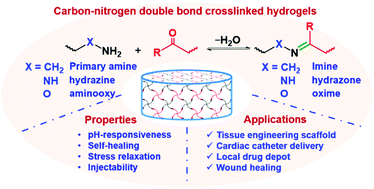当前位置:
X-MOL 学术
›
Mater. Chem. Front.
›
论文详情
Our official English website, www.x-mol.net, welcomes your feedback! (Note: you will need to create a separate account there.)
Hydrogels based on pH-responsive reversible carbon–nitrogen double-bond linkages for biomedical applications
Materials Chemistry Frontiers ( IF 7 ) Pub Date : 2018-09-01 00:00:00 , DOI: 10.1039/c8qm00317c Zhen Zhang 1, 2, 3, 4, 5 , Chaoliang He 1, 2, 3, 4, 5 , Xuesi Chen 1, 2, 3, 4, 5
Materials Chemistry Frontiers ( IF 7 ) Pub Date : 2018-09-01 00:00:00 , DOI: 10.1039/c8qm00317c Zhen Zhang 1, 2, 3, 4, 5 , Chaoliang He 1, 2, 3, 4, 5 , Xuesi Chen 1, 2, 3, 4, 5
Affiliation

|
Covalently-crosslinked hydrogels are formed due to the generation of new covalent crosslinking bonds in situ, leading to the formation of covalently-linked networks. However, traditional polymerization might introduce potential toxicity issues. Recently, carbonyl-condensation reactions that form imine, hydrazone or oxime bonds have become important tools for the preparation of covalently-crosslinked hydrogels for biomedical applications. The formation of imine, hydrazone or oxime linkages occurs under mild conditions with water as the only byproduct. The reactions are reversible and pH-responsive, and are dependent on the chemical structure of the substrates. In this review, we focus on the utilization of the condensation reactions between nucleophiles and carbonyl groups as crosslinking strategies to prepare hydrogels with physiochemical properties sensitive to biologically relevant stimuli. A brief account of the formation mechanisms and stabilities of these linker moieties will help to understand how reactant structure controls the gelation and degradation of hydrogels. Natural and synthetic polymers that are commonly employed as building blocks and synthetic methods that are selected for decoration of different polymers with respective functional groups will be summarized. Then, the preparation and biomedical applications of the hydrogels based on imine/hydrazone/oxime formation will be presented respectively, with special focus on the developments in the past decade. This review will provide insight into the design of novel biocompatible, stimuli-responsive hydrogels based on dynamic linkages for various biomedical applications.
中文翻译:

基于pH响应可逆碳氮双键的水凝胶,用于生物医学应用
共价交联的水凝胶是由于在原位产生了新的共价交联键而形成的,导致形成共价链接的网络。但是,传统的聚合反应可能会带来潜在的毒性问题。最近,形成亚胺,或肟键的羰基缩合反应已成为制备用于生物医学应用的共价交联水凝胶的重要工具。亚胺,或肟键的形成是在温和条件下发生的,水是唯一的副产物。反应是可逆的且对pH敏感,并且取决于底物的化学结构。在这篇综述中,我们专注于利用亲核试剂和羰基之间的缩合反应作为交联策略来制备具有对生物学相关刺激敏感的理化性质的水凝胶。这些接头部分的形成机理和稳定性的简要说明将有助于了解反应物结构如何控制水凝胶的凝胶化和降解。总结了通常用作结构单元的天然和合成聚合物以及被选择用于装饰具有各自官能团的不同聚合物的合成方法。然后,将分别介绍基于亚胺/ hydr /肟形成的水凝胶的制备和生物医学应用,特别关注过去十年的发展。这篇综述将为新型生物相容性,对刺激有反应的水凝胶的设计提供见识,该凝胶基于各种生物医学应用的动态联系。
更新日期:2018-09-01
中文翻译:

基于pH响应可逆碳氮双键的水凝胶,用于生物医学应用
共价交联的水凝胶是由于在原位产生了新的共价交联键而形成的,导致形成共价链接的网络。但是,传统的聚合反应可能会带来潜在的毒性问题。最近,形成亚胺,或肟键的羰基缩合反应已成为制备用于生物医学应用的共价交联水凝胶的重要工具。亚胺,或肟键的形成是在温和条件下发生的,水是唯一的副产物。反应是可逆的且对pH敏感,并且取决于底物的化学结构。在这篇综述中,我们专注于利用亲核试剂和羰基之间的缩合反应作为交联策略来制备具有对生物学相关刺激敏感的理化性质的水凝胶。这些接头部分的形成机理和稳定性的简要说明将有助于了解反应物结构如何控制水凝胶的凝胶化和降解。总结了通常用作结构单元的天然和合成聚合物以及被选择用于装饰具有各自官能团的不同聚合物的合成方法。然后,将分别介绍基于亚胺/ hydr /肟形成的水凝胶的制备和生物医学应用,特别关注过去十年的发展。这篇综述将为新型生物相容性,对刺激有反应的水凝胶的设计提供见识,该凝胶基于各种生物医学应用的动态联系。



























 京公网安备 11010802027423号
京公网安备 11010802027423号